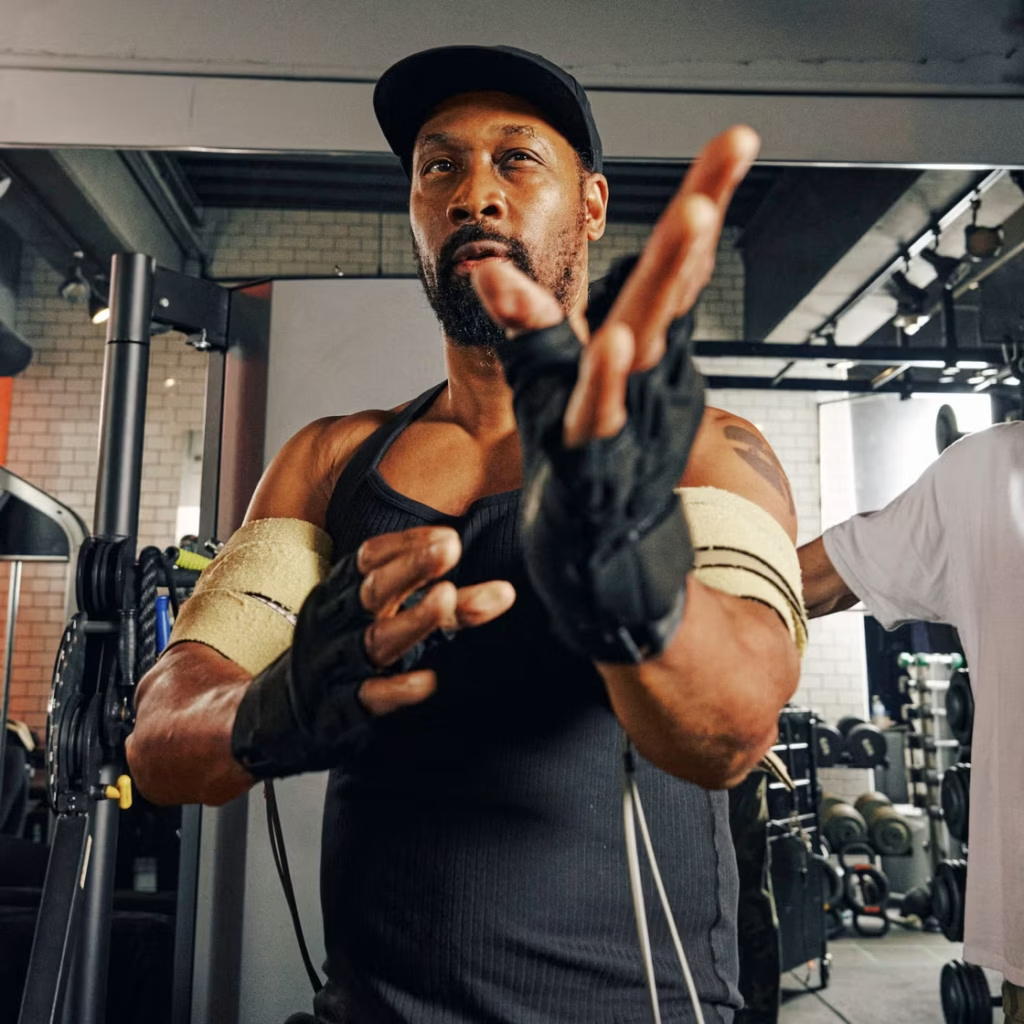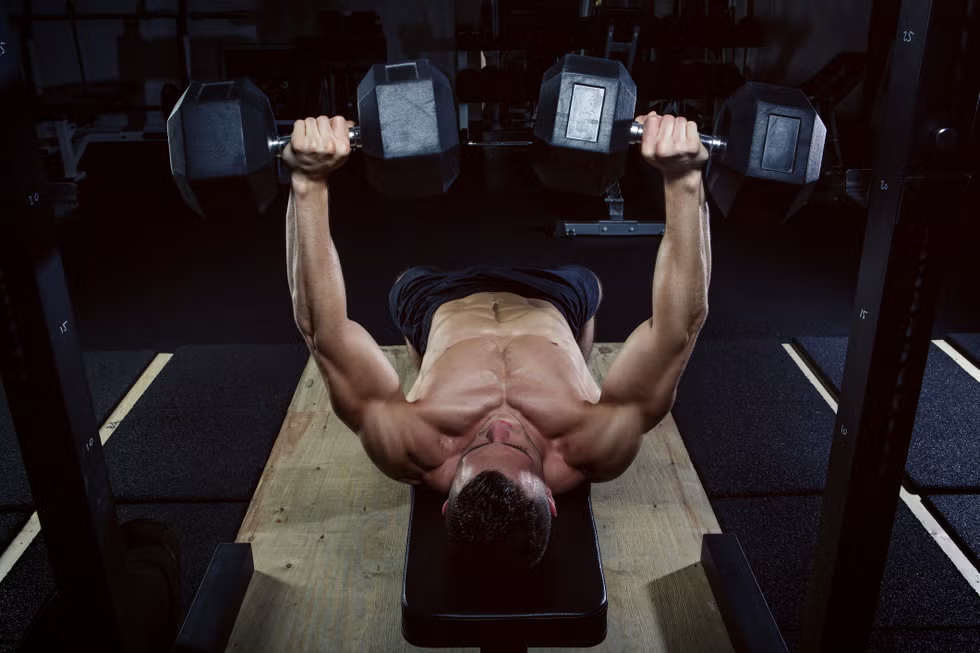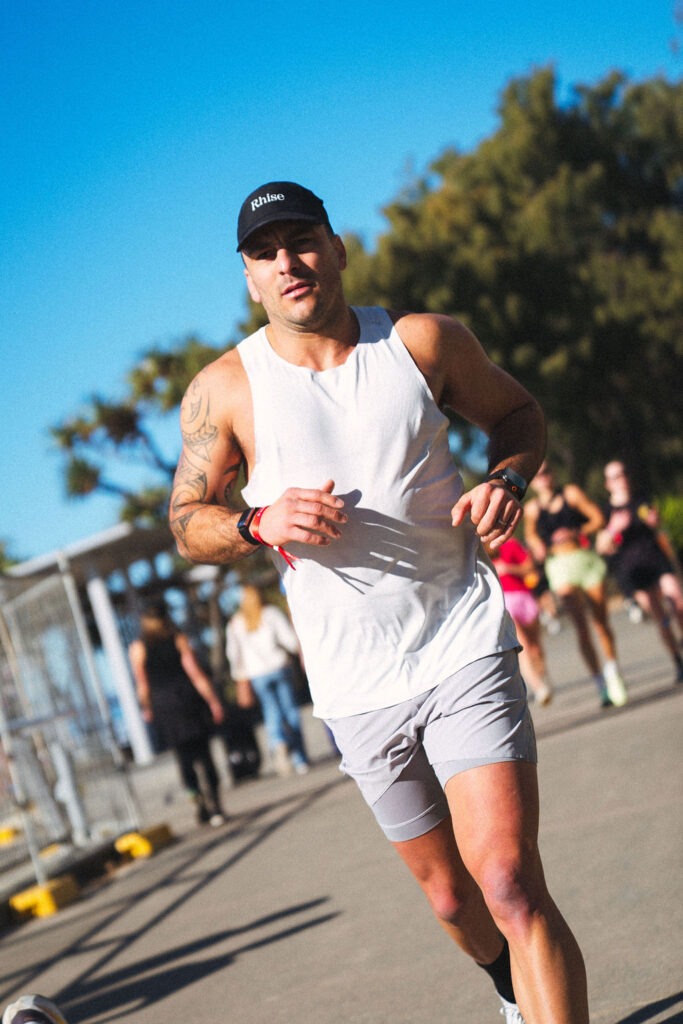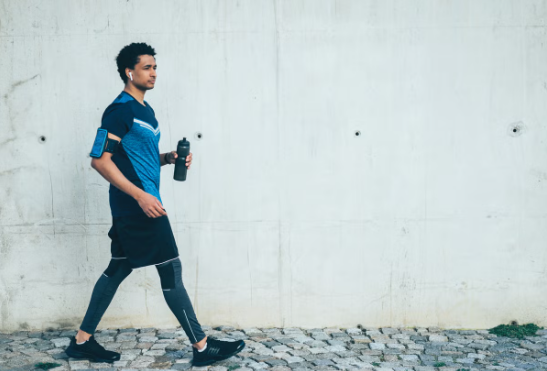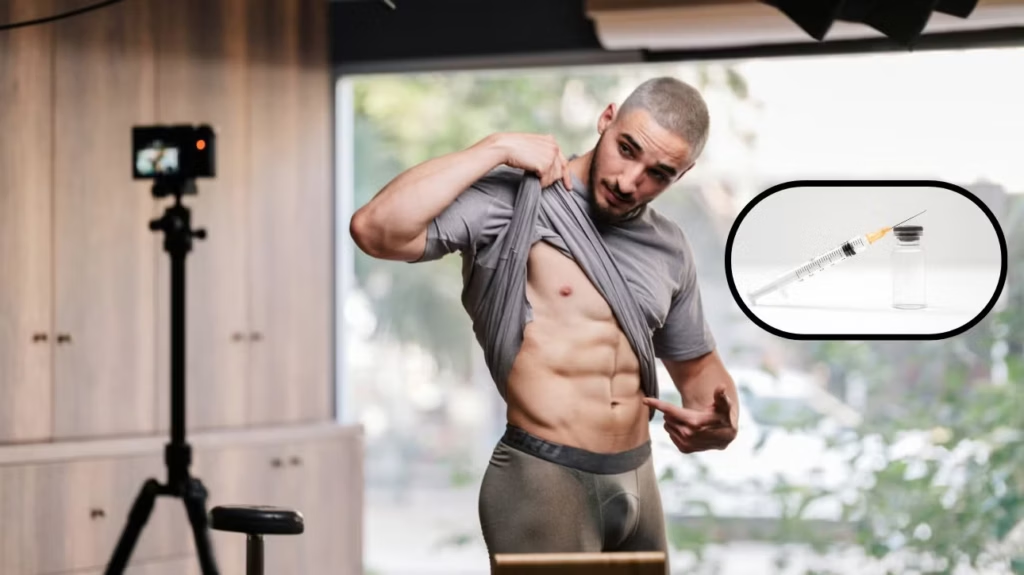‘What are the best exercises to lose weight?’ is a question the staff at Men’s Health get asked a lot. While there’s no true, one-size-fits-all answer for this question (health and fitness looks different on everyone, after all), there are certain exercises and movement formats that can provide a more efficient fat-burn than others. The best part? They’re not complicated at all.
Armed with the right knowledge, equipment and attitude, you can turn up the heat on your fat stores easier than ever. You just have to know how. Here, we explore 25 of the best exercises to lose weight — some more enjoyable than others — that you need in your workout ASAP. The majority of exercises we’ve included can be scaled and adjusted according to your ability and current fitness level, but each exercise should be testing enough to spike your heart rate and, of course, be performed with a load or to a distance that will challenge you. You’ll also notice, hopefully, that none of these exercises are ‘isolated’ and, instead, work at least two muscle groups simultaneously. Efficiency is the goal.
Thankfully, there’s no painful long-distance work here. Instead, just gritty and proven fat-melting exercises that will help you whittle your weight down quicker than your bi-weekly plod around the local park. Expect a mix of lung-taxing cardio, classic strength exercises and conditioning classics. Because, let’s be honest, you didn’t come here for spinning.
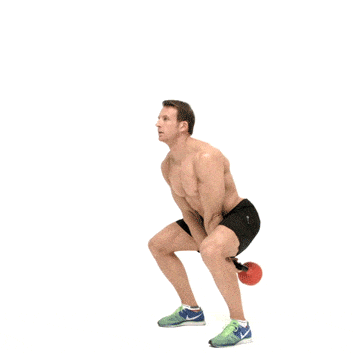
Kettlebell Swings
Why:
Easy to master and one of the most effective exercises for sizzling unwanted paunch, kettlebell swings are an absolute must when it comes to finding the most effective fat-loss exercises. You’ll use your glutes, hips and quads to power the kettlebell upwards, and use your abs to help keep your core stable. Even your shoulders will get some love. All of this will spike your heart rate to melt blubber.
How:
– Bend at your hips and hold a kettlebell with both hands at arms length down in front of you
– Rock back slightly and “hike” the kettlebell between your legs
– Then squeeze your glutes, thrust your hips forward forcefully, and swing the weight to shoulder height
– Reverse the move between your legs and repeat
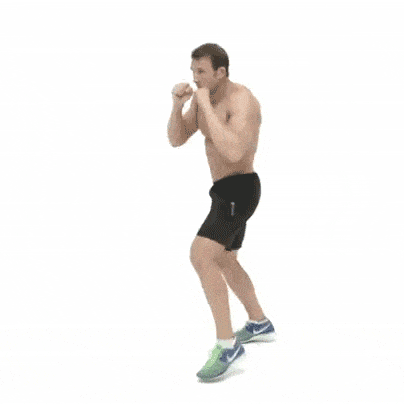
Shadow Boxing
Why:
Working your cardio-vascular fitness, your legs and your arms, shadow boxing deserves a place in any bodyweight workout. Landing a sucker punch to your paunch, research from Forza found that boxing can nuke a red-hot 800 calories per hour. Here’s how nail it.
How:
– Adopt a fighting stance and bounce on your toes as you shadow box
– Dip and weave to your heart’s content
– Cycle between low- and high-intensity punching for a HIIT style cardio workout
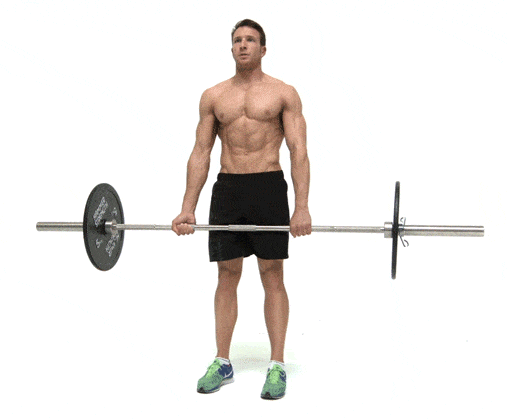
Barbell Deadlifts
Why:
The king of compound exercises, there’s not much a well-performed deadlift can’t do. Be sure to mobilise and warm-up with lighter loads before you hit your working sets, otherwise you’ll put yourself at risk of injury. But here’s the beauty of it: as a compound exercise, the barbell deadlift will hit multiple muscle groups all at once, including your quads, hamstrings, arms, abs and grip strength.
By challenging yourself with progressively heavier weights, you’ll increase your lean muscle mass to, in time, increase your metabolic rate — your body’s process of burning fat.
Here’s a handy tip, too: vary your grip technique between overhand, underhand and hook (one over, one under) to avoid your forearms giving out before your legs do.
How:
– Squat down and grasp a barbell with your hands roughly shoulder-width apart
– Keep your chest up, pull your shoulders back and look straight ahead as you lift the bar
– Focus on taking the weight back onto your heels and keep the bar as close as possible to your body at all times
– Lift to thigh level, pause, then return under control to the start position
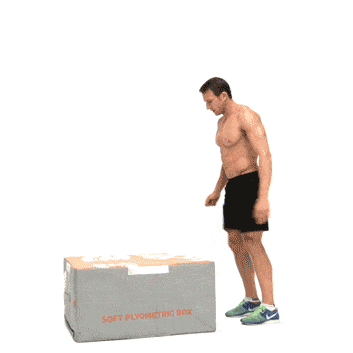
Box Jumps
Why:
Sometimes, you need to step away from the weights room. A simple but seriously effective move, box jumps are ideal for when you’re short on time but still want to give your heart rate a decent spike. You’ll build athleticism — by building power through your legs — which will translate over to bigger lifts, while toning up your body and burning fat.
The American Council on exercise estimates that, when used in a ‘tabata’ format — four sets of 40 seconds on, 20 seconds off — box jumps can scorch over 360 calories after four total rounds.
How:
– Set yourself a comfortable distance from the box with feet shoulder width apart
– Drop quickly into a quarter squat, swing your arms and explode upwards to jump onto the box
– Land as softly as possible. Now step backwards off the box under control
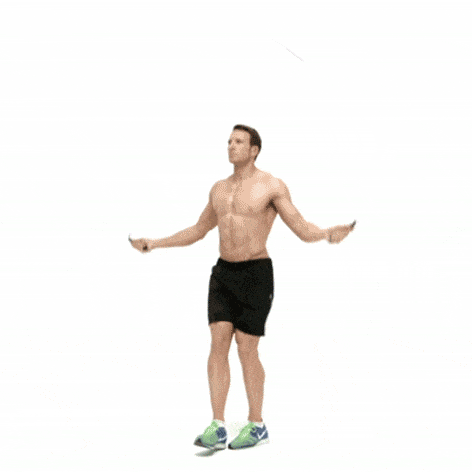
Skipping
Why:
Ever seen a paunchy boxer? Exactly. There’s a reason why pro athletes — from CrossFit legends to MMA fighters — swear by the benefits of the jump rope. They’re light, ideal for conditioning, and can be programmed into any workout, from warm-ups to finishers.
It may not look like it, but skipping can be a full-body workout: you’ll use your shoulders and arms to turn the rope at a quick pace, while your legs and calves will be propelling your body upwards. Keep your core engaged and your abs will get a blasting, too.
“It strengthens the upper and lower body and burns a lot of calories in a short time, but other considerations will determine if it’s appropriate for an individual,” says Peter Schulman, MD, associate professor, Cardiology/Pulmonary Medicine, University of Connecticut Health Centre.
Make the move more intense with double-unders – letting the rope pass round your twice for every jump.
How:
– Grab the rope at both ends
– Use your wrists to flick it round your body, jumping to clear the rope as it hits the ground
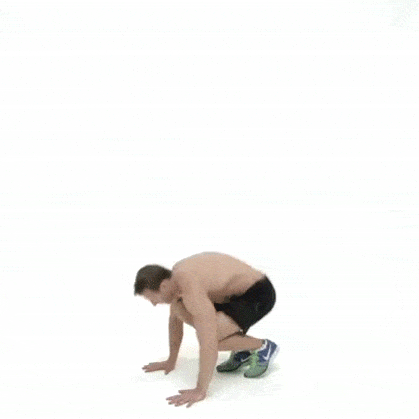
Burpees
Why:
Performing just 10 reps of chest-to-floor burpees at a fast pace can rev your metabolism as much as a 30-second, all-out bike sprint, according to a study from the American College of Sports Medicine. And that means one thing: burning calories.
How:
– From a standing position squat down until your thighs are parallel to the floor and place your palms on the floor
– From there kick your feet back as far as you can while keeping your arms extended
– As soon as your feet land jump them back in towards your hands, then jump up into the air
– Land and immediately squat down to go into the next rep
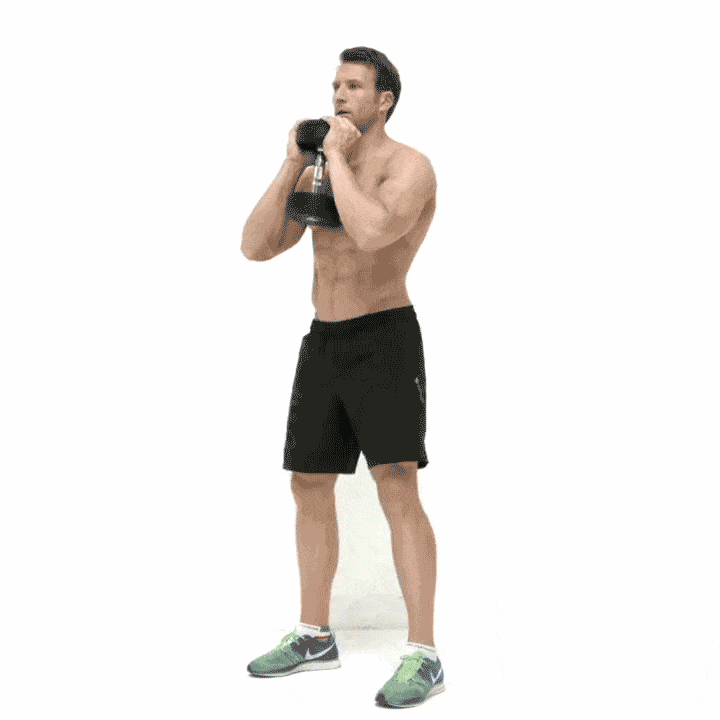
Dumbbell Goblet Squat
Why:
It’s squatting at its most basic. Well, almost. A progression from the simple bodyweight squat, the goblet squat (which can also be done with a kettlebell) is ideal for those looking to build lower-body strength before racking plates up on a barbell.
Similarly, using proper from will encourage your core, shoulders and back to work, while your legs and glutes get a big hit. Plus, this exercise will improve your mobility and, when you move slower, become ideal for time-under-tension training.
A Portuguese study found that squats are the best exercise for burning fat, scorching around 35 calories a minute.
How:
– Stand with feet set wider than shoulder-width and hold a dumbbell with both hands in front of your chest
– Sit back into a squat, keeping the dumbbell in the same position then drive back up and repeat.
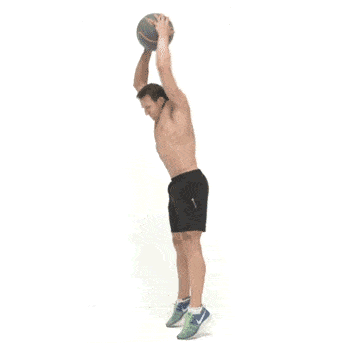
Medicine Ball Slams
Why:
Enjoy taking your frustration out at the gym? Then ball slams are an ideal exercise to lose weight. It’s incredibly simple — pick up something mildly heavy, and throw it down again.
Rinse and repeat for a truckload of benefits that will include muscle gain on your glutes, shoulders and abs, while also spiking your heart rate to sizzle caloriesat an astonishing rate.
How:
– Stand with your knees slightly bent holding a medicine ball above your head with your arms extended
– Bend forward at the waist and use your core muscles to slam the ball against the floor about a foot in front of you
– Let your arms follow through so you don’t fall forward. Catch the ball on its way back up and repeat
Barbell Back Squat
Why:
Much like the barbell deadlift, the back squat is a fundamental compound exercise for getting yourself in shape. Using good form, you’ll need solid strength in your back and core, while having the lower-body power to send the barbell back upwards from the bottom position.
Even a light weight using a high-rep range will improve your metabolism and lead to a greater fat-burn, while building decent muscle for heavier reps will sizzle through your paunch.
As a compound move — an exercise involving several muscle groups — barbell squats, according to this study, will burn fat in overtime, and are considerably more effective than their isolated counterparts.
How:
– Stand with your feet more than shoulder-width apart and hold a barbell across your upper back with an overhand grip – avoid resting it on your neck
– ‘Hug’ the bar into your traps to engage your upper back muscles. Slowly sit back into a squat with head up, back straight and backside out
– Lower until your hips are aligned with your knees, with your legs at 90 degrees – a deeper squat will be more beneficial but get the strength and flexibility first
– Drive your heels into the floor to push yourself explosively back up
– Keep form until you’re stood up straight
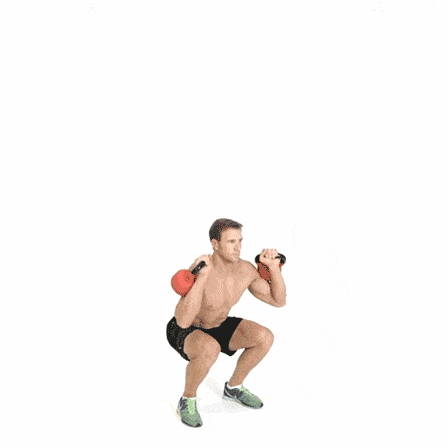
Thrusters
Why:
The dumbbell thruster is, basically, a push press combined with a front squat, but don’t let its simplicity fool you; done correctly, this move can be a full-body workout all on its own. With a barbell or a pair of dumbbells or kettlebells, squat until you’re parallel with the ground. Take it slow. You’ll tax your shoulders, core, grip strength, glutes and quads. It builds a serious engine too.
How:
– Hold two kettlebells by their handles so the weight is resting on the back of your shoulders
– Slightly bend your knees and squat down, keeping your legs in line with your shoulders
– Drive through your legs and straighten them, extending your arms as you do so to raise the kettlebells above your head
– Squat down and repeat
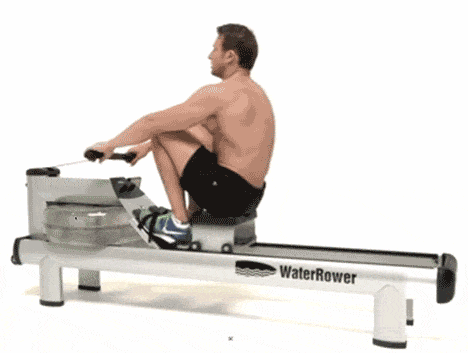
Rowing
Why:
Don’t be put off by the rowing machine’s relative unpopularity in your local gym. Used correctly, it’s one of the best pieces of kit for blasting fat on the double. Avoid long stints in the seat and instead opt for short, sharp interval sessions to hit fat where it hurts.
This study, published in The Strength and Conditioning Journal, found that the metabolic requirements of an interval rowing workout was similar to what was experienced during MMA training, and that a man weighing 83kg can torch around 377 calories by rowing for 30 minutes. Handy when you’re in a pinch.
How:
– Sit at a rowing machine with your feet fastened and grab the handle with an overhand grip
– Straighten your legs to push the seat back – when your hands pass your knees, pull them up to your chest
– Reverse the movement and repeat
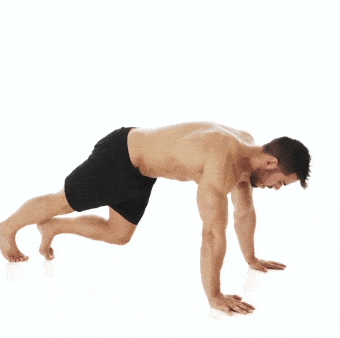
Mountain Climbers
Why:
They make look like a simple move, but mountain climbers require solid form to avoid injury and to get the most out of them. Make sure you’re in a proper position before starting the move — shoulders up, hands under your shoulders, core tight — and drive with powerful knees.
You’ll blast your core and shoulders while building explosive power from your lower-body and ramping up your heart rate. Be sure to keep good posture as you begin to tire and slow down your knee drives if necessary.
How:
– Set up on the floor as though in a sprinter’s blocks, with one foot positioned beneath your waist and one back, with your leg straight
– Explosively swap foot positions
– Repeat for the prescribed reps
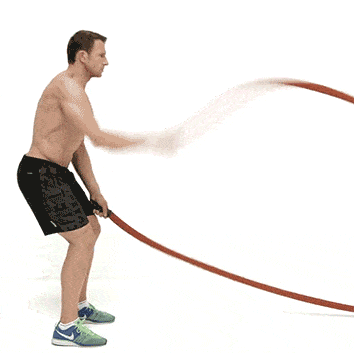
Battle Ropes
Why:
Ready to melt fat like its butter? Good. Battle ropes are hard to beat when it comes to a lung-busting finisher that also packs muscle on your forearms, biceps and shoulders.
The Journal of Strength and Conditioning Research found that ten 15-second bursts of battle ropes upped participant’s heart rate to 180 BPM – the same as an all-out full-body sprint. Don’t feel tied to the weights — a 10-minute battle rope session can rinse through 120 calories. Try moving the ropes in different directions, too: side-to-side challenges stability, circles test shoulder mobility.
How:
– Anchor the rope at its centre 15-20 feet away
– Take an end in each hand with your arms extended at your side. Initiate the movement by rapidly raising one arm to shoulder level as quickly as you can
– As you let that arm drop to the starting position, raise the opposite side
– Continue alternating your left and right arms, whipping the ropes up and down as fast as you can.
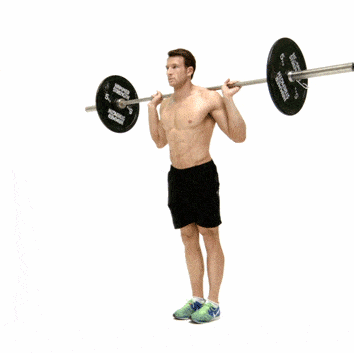
Weighted Lunges
Why:
Take your leg day up a gear or two by adding some weight to your lunges. Barbells, dumbbells and kettlebells are all suitable for spicing up your fat-loss, with the power to build stronger quads and and hamstrings.
Keeping your chest up and avoiding smacking your knee onto the floor, you’ll challenge your core too. Health Statusestimates that a 70kg man will burn 275 calories in half an hour when lunging.
How:
– Stand with your legs under your hips and hold a barbell on your back, or a pair of dumbbells/kettlebells by your side
– Step your right leg out to the side and lower your body as you bend your knee, keeping your left leg straight
– Drive yourself back up to starting position and repeat on the other side

Farmer’s Walks
Why:
Who says fat-burning has to be complicated? Pick up something heavy and move it somewhere else — this is the idea behind the farmer’s walk. Try and use weights that add to a total of half your current bodyweight — 40kg is a good gauge for most men — to tax your grip strength, your core and your upper-back. Farmer’s walks can be fairly low-skill, too. So they make for an ideal bang-for-your-buck exercise.
How:
– Hold two heavy kettlebells or dumbbells by your side
– Keep your arms strong and walk short, quick steps as fast as possible
– Turn around and walk back
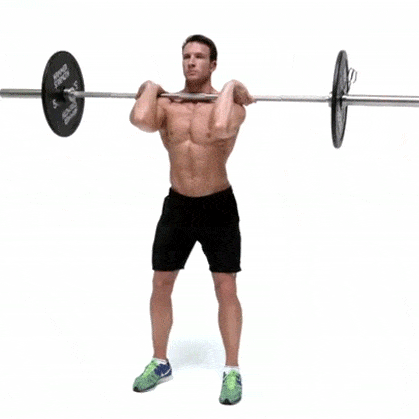
Front Squats
Why:
Squats, but not as you know them — with most guys shying away on this leg-bulking variation, front squats are a great move for burning fat and building strength. Generally, front squats can be safer than barbell back squats, but require a certain degree of mobility to really nail them.
Your core should be fighting to keep your chest upright, while scaling the load to a weight lighter than your normal squatting strength will help you front squat at a faster pace, ramping-up your fat-burn.
How:
– Stand with your feet shoulder-width apart holding a barbell across your upper chest
– You can either support the weight on your fingers, with wrists extended, or cross your arms to support the weight.
– Taking care to not arch your back, push your hips back and bend your knees to lower your body until your thighs are parallel to the floor.
– Drive your heels into the floor to push yourself explosively back up to the start position.
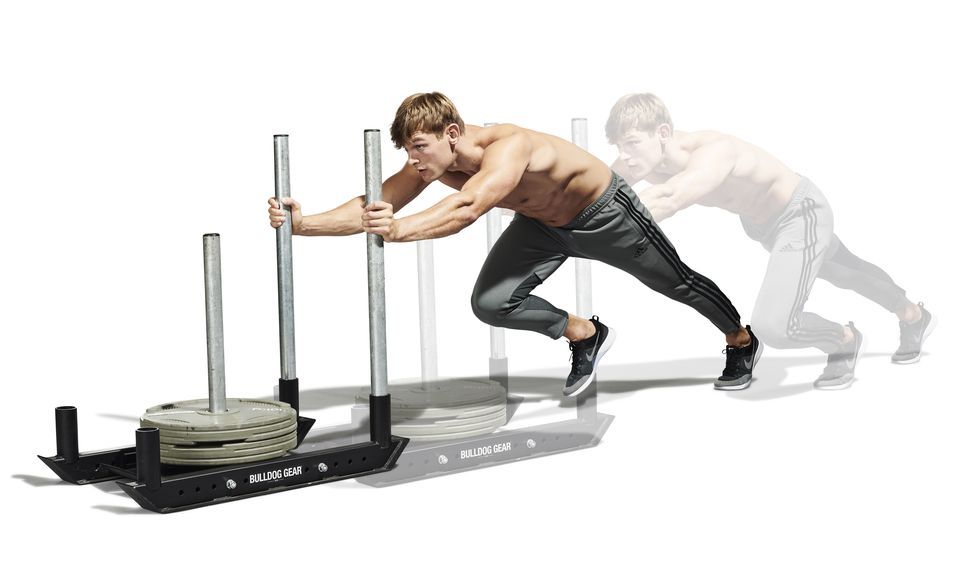
Weighted Sled (Prowler)
Why:
As with the farmer’s walks, the strength and stamina to move a heavy object at pace is a particular skill that many neglect. Pushing a weighted sled is another example of a low-skill move that requires a decent amount of effort.
Load the sled up with around half of your weight, performing rounds of 20-30m runs and back, resting on a 1:2 ratio. You’ll benefit from aerobic and anaerobic gains.
How:
– Set up in an athletic stance – this time with your torso almost parallel to the ground
– Gripping the pipes a third of the way down with your arms locked out, drive the sled by marching forward as fast as you can, bringing one knee up to your chest as your other leg extends behind you
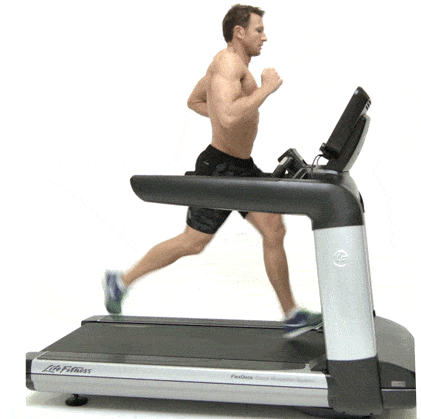
Treadmill Sprints
Why:
Rows and rows of empty treadmills make for a sad sight. While you should be avoiding using them for longer runs (that’s one mile and upwards), the humble treadmill can be an ideal piece of kit for conditioning your body into a furnace.
Use HIIT training methods — short, sharp and intense bursts of exercise to whittle down your fat stores — you can increase fitness and drop weight fast. Start with ten sets of 30/30 sprint-to-rest efforts and look to decrease the rest time while increasing the gradient of the machine. Aim for a constant, fluid pace you can sustain for every effort.
According to the National Academy of Sports Medicine, up to 80 per cent of the calories you’ll burn during a treadmill session will be fat. Handy when you’re in a pinch.
How:
– Once the belt is up to speed, jump on using the treadmill hand rails
– Make sure you land with your forefoot first – the impact will be absorbed by your quads, rather than your joints
– As soon as your foot touches, drive up with your back knee to power forward in a big stride. Imagine a line reeling in from your shoulder to knee
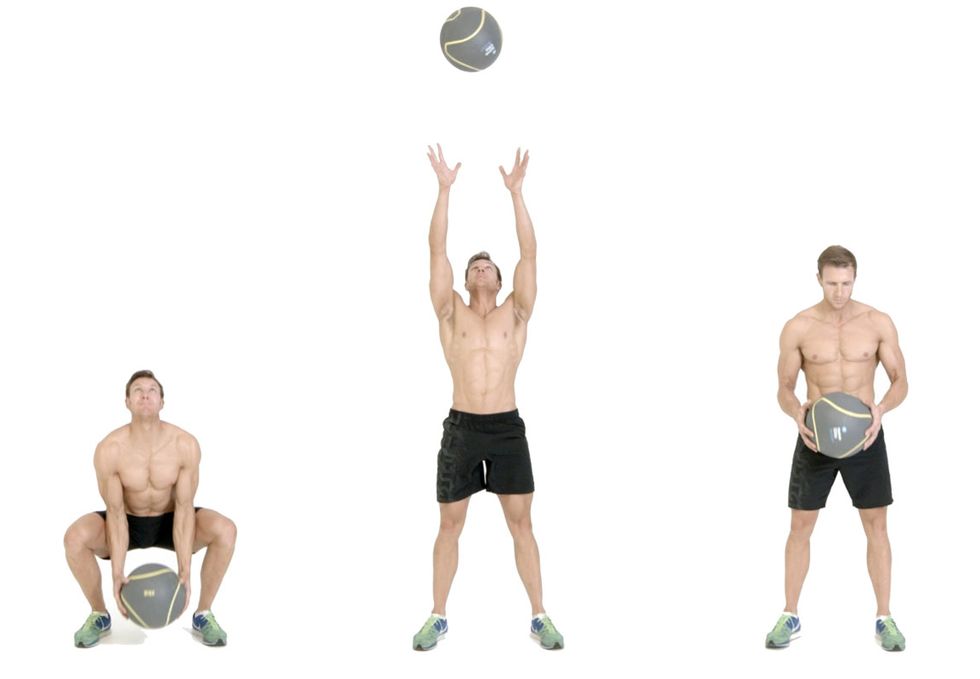
Wall Balls
Why:
A CrossFit favourite, wall balls are a fantastic exercise for developing power and upper-body strength, especially when under oxidative stress. The squatting part of the movement will gas your calves, quads and hamstrings, while the upward movement of throwing the ball overhead will power your chest, shoulders and back. Plus, wall balls will build functional muscle and increase your V02 max.
How:
– Grab a medicine ball that you’re comfortable with launching up to 10ft
– Holding the bottom of the medicine ball at your chest, squat down until your thighs are parallel to the floor
– As you push back upwards, use your momentum to throw the ball against the 10ft marker on the wall
– Catch the ball on the rebound and repeat the movement for reps
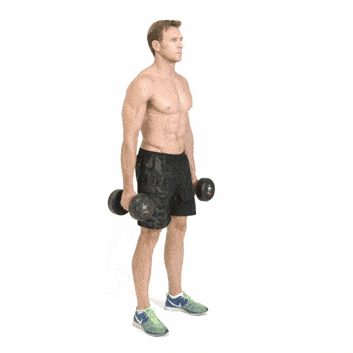
Dumbbell Deadlifts
Why:
Don’t feel comfortable with the conventional bar deadlift? No dramas — the dumbbell deadlift is an ideal scaling option for those looking to build strength before hitting the bar.
It’s another good example of a full-body exercise that can be done almost anywhere — from home to hotel gyms — with a truckload of benefits including total-body strength, grip improvement and better mobility. Thankfully, all these will transfer over to the barbell deadlift, helping you build stronger quads, glutes, traps and core.
How:
– Hold two dumbbells in front of your thighs, palm facing inwards
– Slowly lift one leg straight behind you, bending the other slightly, and lean forward so that your arms lower the dumbbells towards the floor
– Pause, then return to upright position
Assault Bike
Why:
A truly fiendish piece of fitness kit, the assault bike is one of the most threatening pieces of equipment against your fat. It’s simple really, you sit on the bike and ride like hell until you can’t anymore — then do that a few more times.
The trick is, however, that the harder you push and pedal the bike, the harder the work becomes, as the resistance setting responds to your pace. Just don’t give up. Aim for quick sprints — 15 seconds, or 12 calories are ideal benchmarks — resting for a 1:2 ratio for five rounds or above.
What’s more, Quantum Strength & Power Training: Gaining the Winning Edge found that the assault bike is an ideal training tool for increasing aerobic capacity without eating your muscle.
How:
– Adjust the saddle to hip height, and take a seat
– With your feet in the pedals, push with your left foot and with your right hand on the handles, and vice-versa
– Don’t be tempted to take it easy — thrash the handles and pedal like your life depends on it to get the most out of the world’s most uncomfortable bicycle
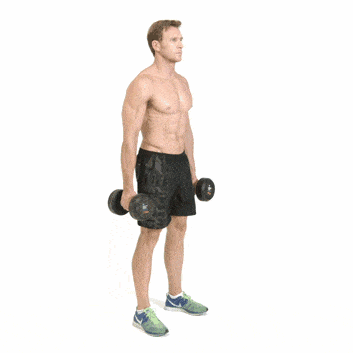
Dumbbell Step-Ups
Why:
Dumbbell step-ups are a sure-fire exercise to maximise your gluteus maximus, the major muscle responsible for extending, rotating and adducting and abducting from the hip joint. Single leg exercises also increase stabiliser strength of the smaller muscles around the joint, protecting you against injuries.
The dynamic nature of dumbbell step-ups will help you burn fat while improving upper-body strength and athleticism. Be sure to keep increasing the weight of the load as you progress.
How:
– Place your right foot onto the elevated platform and push up through your heel
– Step back down with your left foot, concentrating on flexing your hip and the knee of your right leg
– Repeat on the other side
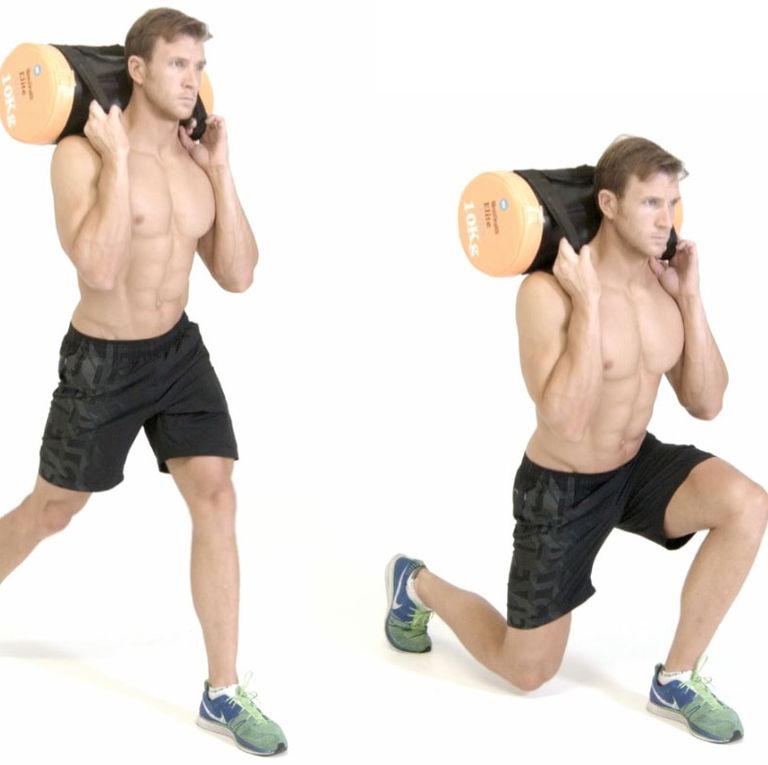
Sandbag Forward Lunge
Why:
One type of equipment that’s used even less than the treadmills are the sandbags. Use them right and you’ll build more functional muscle than you’ve ever had. While they’re not a worthy substitute for dumbbells or barbells, the beauty of sandbags comes not from their weight, but from their instability.
As the sand moves around inside the bag, your stabilising muscles will be working overtime to keep you balanced. Keep your core braced to avoid injury and to maximise muscle recruitment.
Roughly speaking, it’s estimated that you can burn upwards of eight calories a minute — that’s 80 calories every 10 minutes or 240 calories every 30 minutes — using sandbags.
Study findings from University of Wisconsin-Milwaukee saw sandbag training (over dumbbells or kettlebells) causes participants’ hearts to beat around 8bpm faster. This correlates with great energy expenditure and calories burned.
How:
– Place the sandbag across your back
– Step forward with your right foot and sink into a lunge, so both legs are bent with your back knee as close to the floor as possible
– Drive yourself back up and repeat on the other side
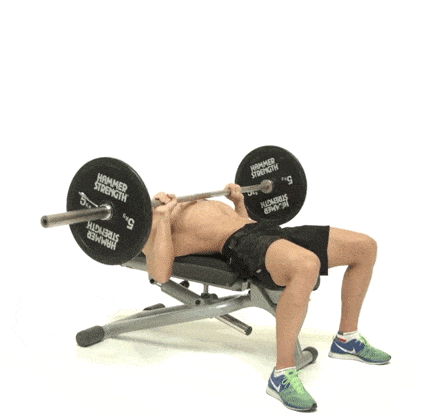
Bench Press
Why:
The classic barbell bench press sends your testosterone levels into overdrive by engaging your arms, chest and shoulders simultaneously — a true compound move. Handily, the more you push, the more calories you burn: that’s according to research published in the Journal of Strength & Conditioning Research, confirming the barbell bench press as an ideal weight-loss exercise.
How:
– Lie back on a flat bench holding a barbell in the rack above you with a shoulder-width, overhand grip
– Lift the bar off the rack and position it above your chest with arms fully extended
– From the starting position, breathe in and lower the bar slowly until it skims the middle of your chest
– Push the bar back to the starting position explosively as you breathe out. That’s one rep
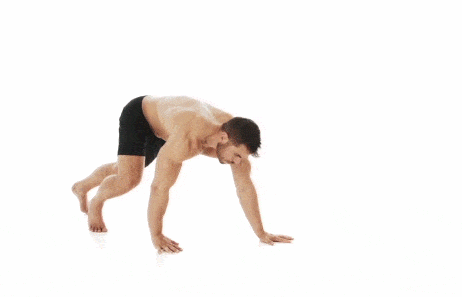
Bear Crawls
Why:
Ignore the curious looks you’ll get when performing the ab-busting bear crawl. It’s a basic movement at its most functional, helping you improve your core strength and control while increasing muscular endurance in your abs, legs, shoulders, arms and chest.
Use it as part of your warm-up to activate your muscles and help stabilise your body for a more efficient fat-burn once you hit the weights.
How:
– Begin on all fours with your hands under shoulders and your knees under your hips — all lifted off the floor
– Keep hips slightly higher than the shoulders, chin tucked in and head in a neutral position
– As you reach with the right arm, reach with the left foot so opposite arm and leg work together as you begin to move forward
– Keeping your hips even throughout the movement, begin with small steps until you’ve mastered both movement and co-ordination








